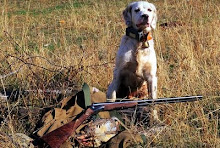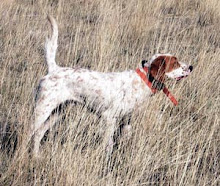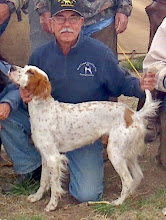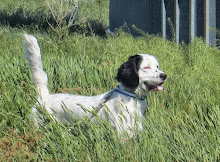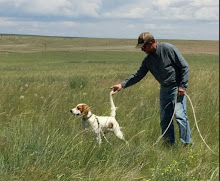Canada wild rye - a dangerous grass, one among many you may encounter this Summer or Fall
Summer, and the time that many of us begin training dogs for the Fall season. Spring was late in the northern prairie. There has been a lot of rain/snow in most places this year and grass is high. There are a number of grasses that pose a serious and widespread risk to dogs, and this seems a good time to post again about the hazards or grass awn infections.
My setter, Ted, had a nasty infection from a cheat grass awn in his front paw last season that sidelined him for much of the season. With treatment, he recovered completely. But grass awns can kill your dog. They may be inhaled and cause disabling or fatal lung infections, or enter the mouth and be swallowed when the dog drinks and infect/perforate the walls of the stomach and digestive tract, or they can enter the dog's body through the skin and travel remarkable distances carrying infection with them. None of this is easily diagnosed or treated.
I am heading to Montana to work with my dogs on sharp-tails, young pheasants, and Huns for a couple of months at the end of July. Through Torben Hansen's thoughtfulness, I received a copy of documents by Cathy Lewis and Dr. Pat McInteer, DVM that were presented by Cathy at the Purina Pointing Dog Awards weekend last month. She has consented to my reproducing parts for her work here on Living with Bird Dogs. I'll put some links and citations at the end of this post and encourage anyone to learn more about this widespread and not easily diagnosed health risk. Here is the her (slightly edited) paper:
Grass Awn Infection, by Cathy Lewis (e-mail) and Dr. Pat McInteer, DVM
...you are your dogs best defense against this danger. Learn to recognize threats and avoid them, and carefully observe and know your dog. Recognizing subtle changes early may make a huge difference in successful treatment should your dog fall prey to a grass awn infection.
The most common grass threats to our dogs (my comments in brackets):
Foxtail Barley – if your live, train and/or compete (or HUNT) in the western United States or Alaska, especially, but this foxtail is spreading throughout the U.S.
Cheatgrass – a known threat in the Rocky Mountain states (and the entire Great Basin). Residents know that this becomes a problem when the grass begins to dry and drop its seeds, sometime around July, through the first freeze or snow.
Canada wild rye – unlike the above, this grass is actively cultivated as an effective cover crop for other, slower to establish grasses. It features a particularly aggressive awn. Popular with state and federal conservation authorities, and bird and habitat preservation organizations due to its low cost, it has become widespread through the Midwest and Mideastern states over the past ten years.
Find a full list of known problem grass species at www.meanseeds.com
Grass awn infections can manifest in multiple symptomspatterns (or combinations thereof): pyothorax (an infection in the chest cavity), pneumonia, and/or body wall or internal abscesses. Based on my experience and the case histories I am gathering, Many infections show up as an acute illness. The dog seemed fine two hours ago/yesterday, but nows/he has an elevated temperature, is lethargic, and has no interest in food…
The symptoms of a grass awn infection overlap those of other fairly common threats, such as tickborne disease. Your powers of observation may be key in making an accurate diagnosis quickly. If you have reason to suspect that your dog has been exposed to a problem grass, make your veterinarian aware of that fact and the likely manifestations. Veterinarians that do not see many working dogs in their practice may not consider the grass awn possibility in their early workup.
Treatment in most cases is costly. Even “medical management” of a pyothorax (Chest infection) is most times not a matter of simply giving some pills. With my own dogs, treatment costs have ranged from approximately $1000 to $12000...
In most cases that I am aware of where treatment has successfully resolved the infection, the dog's health has been restored to the point of returning to the field, though for competition dogs the consequences of surgery, e.g. removal of a lung lobe, ribs, and/or muscle tissue may effect performance to the point where retirement becomes advisable.
Sadly, the threat of grass awn infection appears to be rising. YOU are your dog's best defense.
Be careful out there...
Links:
Nocardia Infections in Bird Dogs, Dr. Pat McInteer, Dr. Kames Mills, and others



